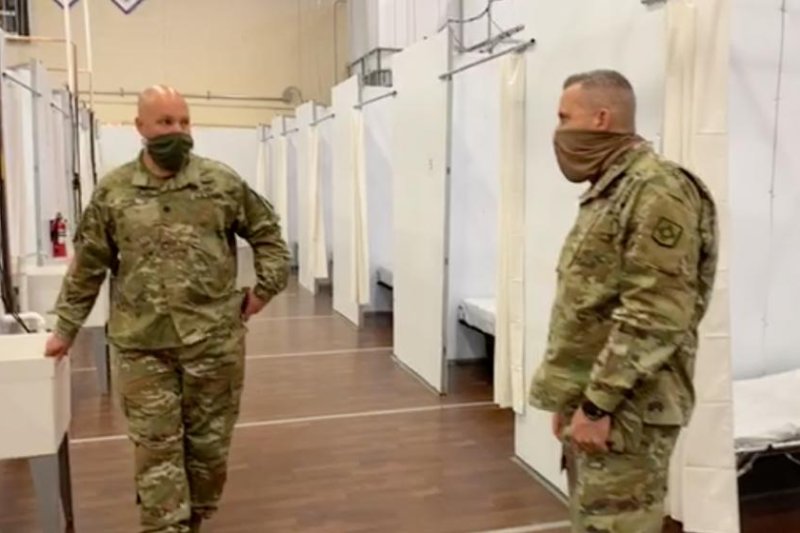
Care on the Navajo Nation has been expanded with recovery centers built by U.S. Army Corps of Engineers and FEMA as the COVID-19 pandemic sickens more reservation residents. Photo via FB Live, courtesy of the Navajo Nation.
DENVER, April 24 (UPI) -- Expecting the cases of COVID-19 on the Navajo Nation to peak in mid-May, the U.S. Army Corps of Engineers and Federal Emergency Management Agency are constructing three reservation field hospitals to be used as alternative care sites, the tribe said Friday.
"COVID-positive patients will be kept here isolated so they can recover here and then go home," said the nation's President Jonathan Nez said in a live video feed from the Miyamura High School gymnasium in Gallop, N.M., which had been converted into a 60-bed recovery center.
"It looks nice, but believe me, you don't want to end up here, you don't want to be away from your family for a long time. ... We're preparing for a worst-case scenario," Nez said.
Two other care sites are being built in Chinle, Ariz., and Shiprock, N.M., Nez said.
RELATED Navajo Nation extends shelter-in-place order for COVID-19 outbreak
The reservation, with a population of around 175,000 people, has been a national hotspot for reported positive cases of the coronavirus. Its an infection rate is higher than any state except New York and New Jersey, according to state health care department statistics.
The Navajo Epidemiology Center has reported 78 new cases confirmed positive cases since Wednesday, reaching a total of 1,360.
Fifty-two deaths on the reservation have been attributed to the virus, and about 7,500 tests have been completed. The average age of positive virus patients was 43, and the average age of death was 65, the health agency said.
RELATED Navajo leaders self-quarantine after COVID-19 exposure
As the reservation prepares for a third weekend curfew and stay-at-home orders, the tribal government on Thursday organized a drive-through distribution of care packages, food supplies and firewood to about 250 remote reservation residents in Jeddito, Ariz.
The Window Rock, Ariz.,-based Navajo Times newspaper has published a list of resources and non-profit groups that were providing emergency relief to tribal members.
The Navajo Nation, about the size of the state of West Virginia, has only 13 grocery stores, and about 30 percent of residents lack running water or electricity.
RELATED Solar-powered cisterns bring running water to Navajo homes
The Hopi Nation, located within the Navajo Nation, has three villages with no running water, Cassandra Begay, communications director for the non-profit Navajo & Hopi Families COVID-19 Relief Fund, said in a video.
The group has delivered 1,500 food baskets across the two reservations and is coordinating volunteers to sew masks for residents, especially the elderly.
"In many homes on the reservation, there are multi-generational families that live there," Jessica Stago, who coordinates water for the relief effort, said in a statement. "The virus is attacking this important family unit by spreading among entire families who cannot isolate from each other," she said.
Meanwhile, on Wednesday, the Navajo Nation joined a multi-tribe lawsuit filed in U.S. District Court for the District of Columbia that asks the U.S. Treasury Department to exclude 230 Alaska Native corporations from the $8 billion in federal COVID-19 relief of CARES Act funds.
Three Sioux tribes, the Cheyenne River, Oglala and Rosebud Sioux, and others, including three Alaskan native tribes, say the corporations are for-profit entities, owned by shareholders, many of them non-Indian.
"Allocating funds from the Coronavirus Relief Fund to the Alaska Native corporations will severely impact the Navajo Nation's ability to fight COVID-19, and will impact every other tribe, as well," Navajo President Nez said in a statement.
No comments:
Post a Comment